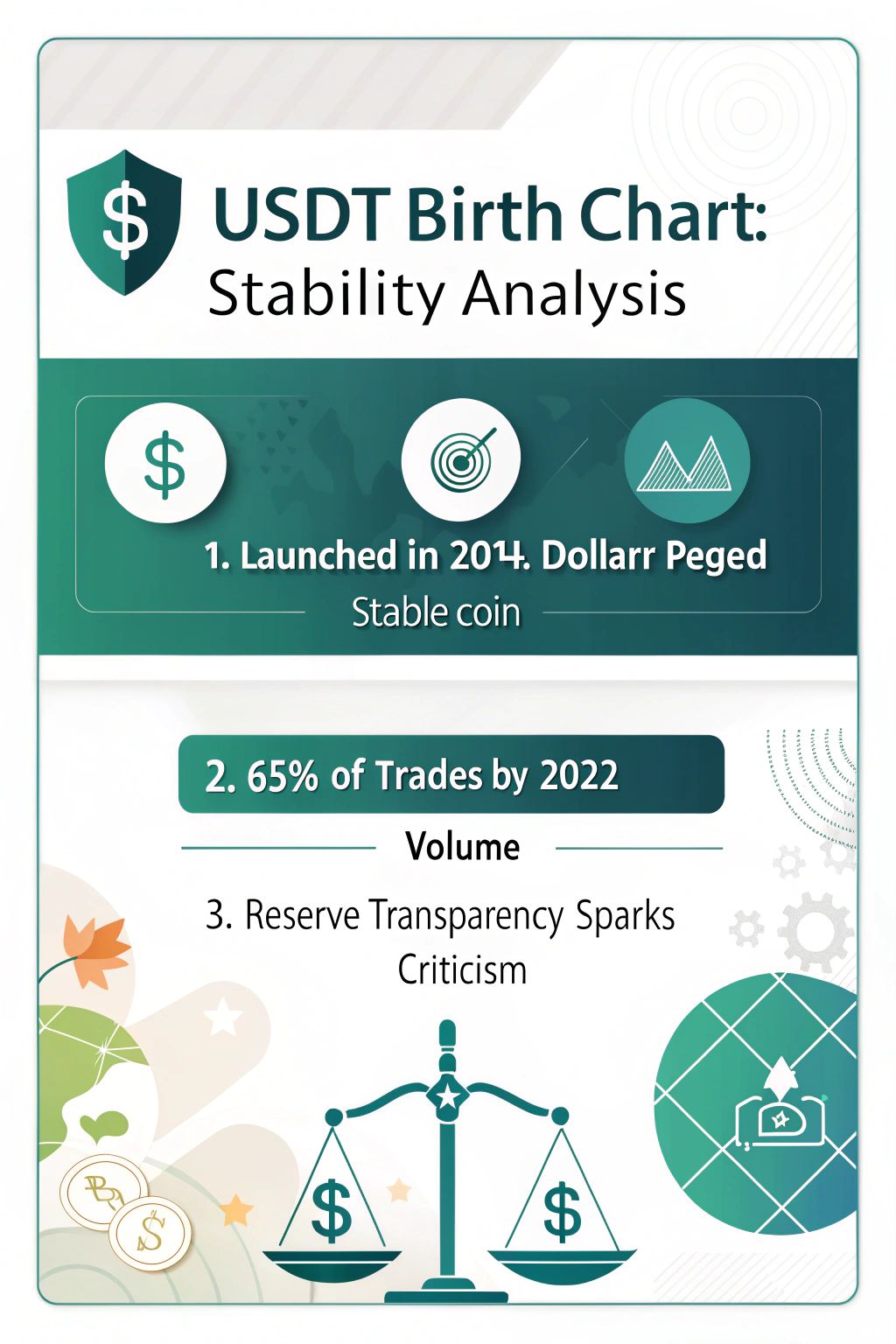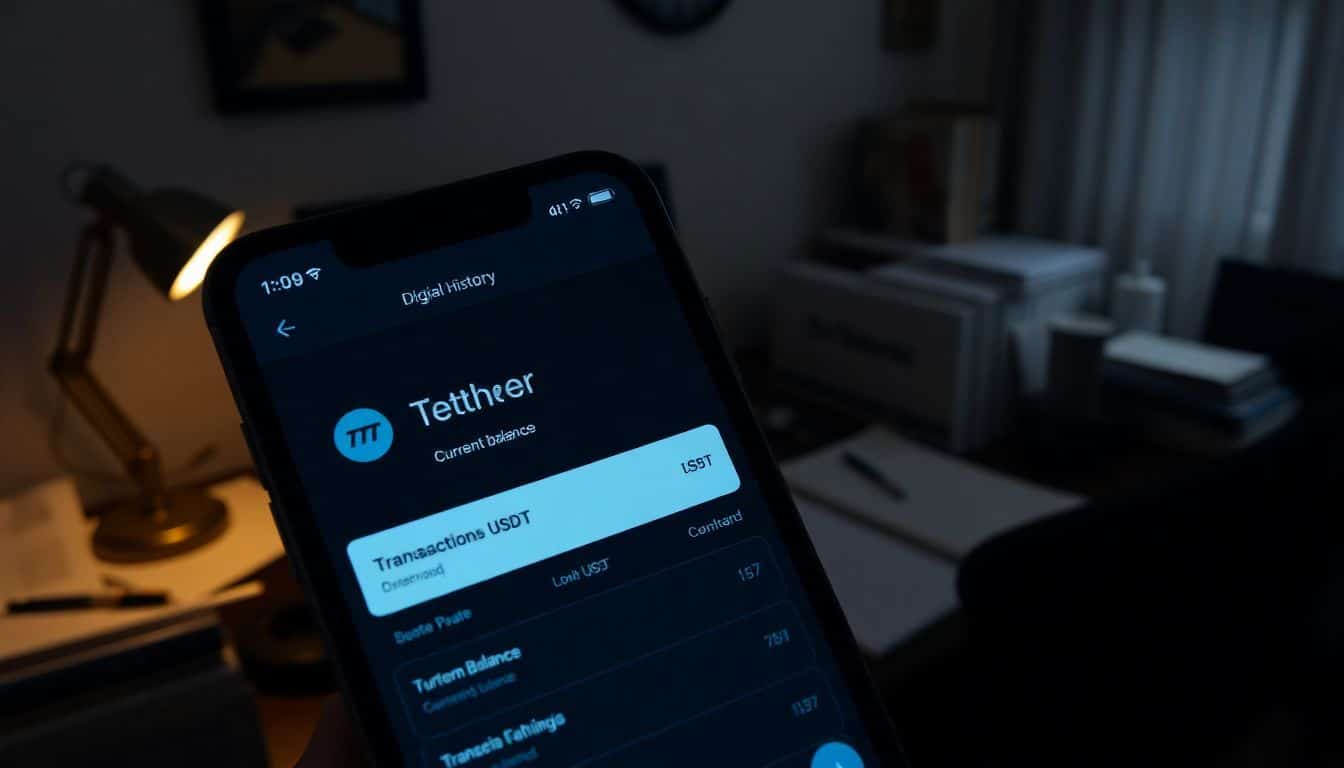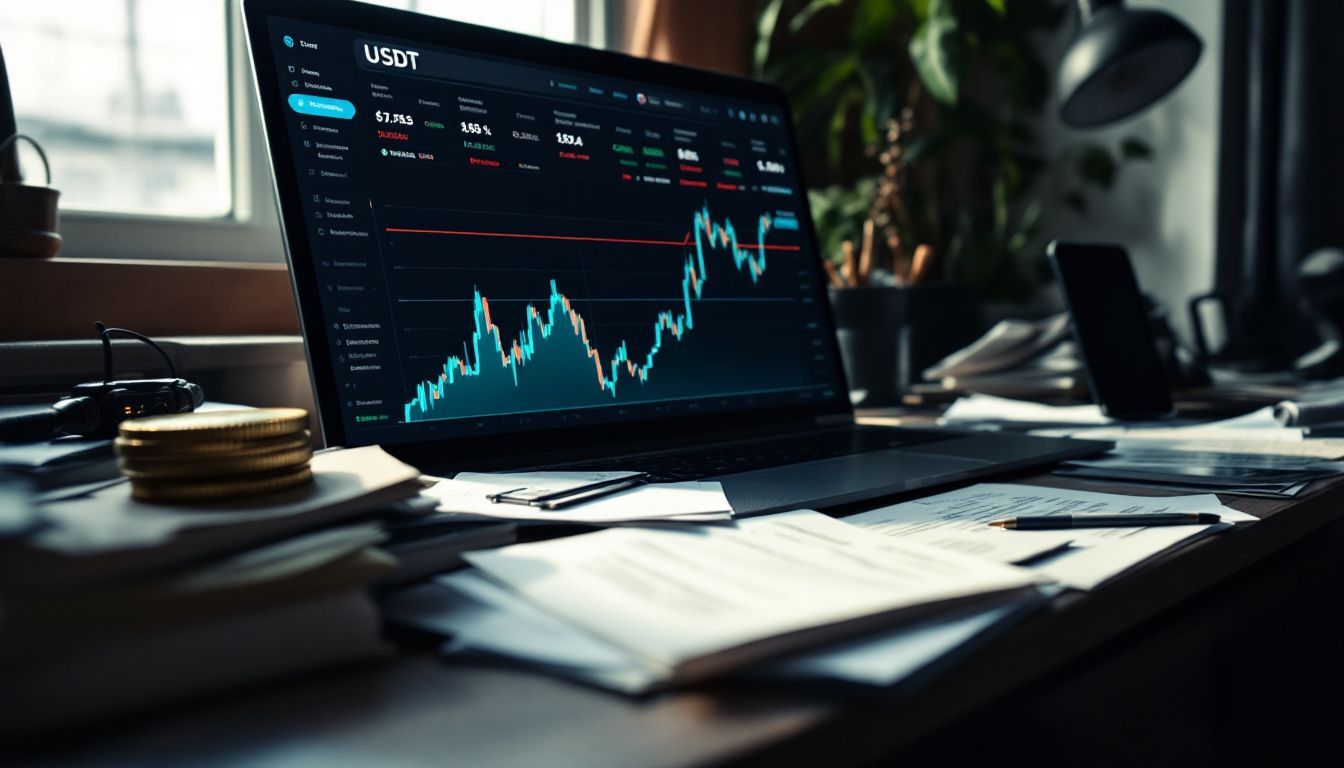Keeping your money stable in crypto markets can feel tricky. Tether (USDT) is a popular stablecoin tied 1:1 to the US dollar, helping reduce that risk. In this blog, we’ll break down how USDT holds its value and impacts trading.
Stick around—it’s worth understanding!
Key Takeaways
- USDT, launched in 2014, is a stablecoin pegged 1:1 to the U.S. dollar, helping traders reduce risk during volatile crypto markets.
- By 2022, USDT dominated trading with 65% of all crypto trades and surpassed Bitcoin in daily trading volume. It remains vital for liquidity on exchanges like Binance.
- Critics question Tether’s reserve transparency; limited audits create doubts about its ability to fully back USDT tokens.
- Legal challenges since 2018 led Tether to settle cases but also increased regulatory scrutiny globally on stablecoins’ financial claims.
- Investors use strategies like holding USDT during bear markets or converting profits into it during bull runs as a hedge against price swings.

Evolution of Tether (USDT) Since Its Inception

Tether (USDT) started in 2014 as one of the first stablecoins, aiming to tie digital coins to real-world money like U.S. dollars. Over time, it faced rapid growth and its fair share of questions about reserves and trust.
Creation and early years (2014-2016)
Launched in 2014, Tether aimed to solve fiat-to-crypto banking problems. It created USDT as a stablecoin tied to the U.S. dollar. Each USDT was meant to equal one dollar, offering trust during volatile crypto trades.
Between 2014 and 2016, adoption steadily grew. Traders found value in its stability amid bitcoin’s price swings. Exchanges like Bitfinex began supporting it early on, boosting its popularity.
This period set the stage for later expansion and debates around transparency and reserves.
Expansion and controversies (2017-2018)
Tether gained major traction during 2017’s cryptocurrency boom. Trading volume soared as bitcoin prices surged, with USDT becoming a key tool for liquidity. It processed billions daily, helping traders move funds quickly without converting back to fiat currency.
Accusations surfaced in 2018 about its reserves backing the token. Critics questioned if each USDT was truly pegged to a U.S. dollar, sparking heated debates. Legal scrutiny followed, and Tether faced mounting pressure from regulators.
These controversies raised doubts about transparency but didn’t stop its widespread use in exchanges like Binance and Bitfinex.
Recent developments and global adoption (2019-present)
By 2019, USDT solidified its role in crypto trading. Its daily trading volumes soared past Bitcoin’s by mid-2022. March 2022 data showed Tether accounting for 65% of all crypto platform trades, cementing its dominance.
Emerging markets embraced USDT as a tool to counter inflation and unstable currencies like the Turkish lira. Traders relied on it during price swings, especially in bear markets. The adoption extended across decentralized exchanges and wallets due to low gas fees and convenience.
Tether’s Impact on Cryptocurrency Markets
Tether plays a big role in making trades smooth and fast. Its stability keeps markets running even during wild price swings.
Role in liquidity and trading volume
USDT boosts trading volume by acting as a bridge between digital assets and cash. On cryptocurrency exchanges, it pairs with tokens like Bitcoin and Ethereum to provide smooth trades.
Stablecoins, including USDT, supply 45% of liquidity on decentralized exchanges (DEXs). This makes them crucial for market efficiency during high demand or volatile shifts.
Exchanges rely on USDT to keep transactions steady. It ensures quick swaps without needing direct conversions to USD or other fiat currencies. For traders handling cryptoassets in bulk, this cuts down costs and limits delays.
Without stablecoins like USDT, maintaining market flow would feel like driving with no fuel in the tank.
Liquidity is oil; trading thrives where the supply is smooth.
Influence on bitcoin price stability
Tether’s impact on Bitcoin price has been significant. Stablecoin emissions, like those of USDT, often inject liquidity into cryptocurrency markets. This can fuel trading activity and increase Bitcoin’s volatility during certain periods.
For instance, as USDT’s market cap grew from €23 billion in early 2021 to nearly €150 billion by Q1 2022, its sheer size influenced the flow of funds into Bitcoin.
In mature markets, these effects tend to fade. As the market expands and adapts, traders rely less on single stablecoins for transactions or holdings. Macroeconomic factors also play a larger role over time.
Yet there are still moments when Tether injections nudge prices upward or stabilize dips briefly before broader trends take control again.
USDT vs. ETH: Strategic Considerations for Conversion
Switching between USDT and ETH depends on your goals and the market’s pulse. Keep an eye on trading volume, price trends, and macroeconomic factors to time moves wisely.
Market conditions favoring conversion to USDT
High inflation rates often push investors toward stablecoins like USDT. Its peg to the U.S. dollar offers a hedge against devaluing assets during such times. In 2022, rising interest rates and market instability saw traders shift into USDT for safety.
Crypto downturns marked by low Bitcoin RSI readings (below 30) further encourage this move.
Extreme trading volumes during bull peaks signal caution, too. Converting volatile crypto assets to USDT can lock in profits when markets bubble near all-time highs. For example, Bitcoin surging past $60K in late 2021 led many to secure gains using Tether’s stability as a shield against price corrections.
Situations ideal for converting USDT to ETH
Price corrections in ETH markets create good chances to convert USDT. For example, double bottoms or inverse head and shoulders patterns signal potential price rebounds. These technical setups often mark strong entry points for Ethereum investments.
Bull markets heavily favor moving USDT into ETH. Rising demand boosts cryptocurrency prices, including Ethereum. Network growth during such periods adds more value to ETH as decentralized applications scale rapidly.
Next, let’s explore the financial stability of USDT.
Financial Stability of USDT
USDT pegs its value to the U.S. dollar, aiming for stability in a fast-moving market. Yet, concerns linger over its reserves and transparency claims.
Analysis of USDT’s peg to the U.S. dollar
Tether uses reserves to keep a 1:1 peg with the U.S. dollar. These reserves include cash, bonds, and other assets. In May 2022, market stress caused a brief de-pegging event. For a short time, USDT traded below $1 on some exchanges but quickly recovered.
Critics have questioned Tether’s reserve transparency for years. The company claims its holdings back every issued token, but audits remain limited. Stablecoins like USDT depend on market confidence.
Any loss of trust could impact its price stability and trading volume significantly in cryptocurrency markets.
Examination of reserve claims and transparency issues
Reserves claimed by Tether include cash, Treasury bills, and commercial paper. In March 2022, 47.6% of its reserves were in US Treasuries, while 24.4% came from commercial paper. Critics often question these reserve claims due to limited audits and clarity.
Transparency remains a sticking point for many. The company provides reports but lacks full external verification. Investors want clearer data on the assets backing USDT’s $1 peg.
This uncertainty can shake trust during market downturns or sudden redemptions in cryptocurrency trading markets.
Legal Challenges and Regulatory Scrutiny
Tether has faced heat over its claims of being fully backed by reserves. Lawsuits and investigations have pushed it to boost transparency and address doubts about financial stability.
Overview of legal cases involving Tether
Legal challenges have targeted claims about Tether’s reserves. In 2021, the New York Attorney General (NYAG) found gaps in reserve transparency. Tether and Bitfinex paid $18.5 million to settle without admitting wrongdoing.
Investigators claimed USDT was not fully backed at times.
Other regulatory bodies questioned its reserve composition during volatile markets. Critics highlighted inconsistencies in maintaining the 1:1 U.S. dollar peg. These cases brought more pressure from global regulators as USDT gained dominance in cryptocurrency trading volume and liquidity activities.
Regulatory responses and compliance measures
Tether faced sharp regulatory scrutiny over its reserve composition. The EU’s MiCA Regulation aims to tackle risks tied to such stablecoins. This includes ensuring clear reserve backing and preventing market instability.
U.S regulators have also questioned Tether’s transparency regarding its dollar peg.
Agencies like the CFTC fined Tether $41 million in 2021 for “misleading claims.” These actions push stablecoin issuers toward better practices. Governments now demand stricter audits and disclosures from firms like Tether.
Such measures aim to protect cryptocurrency markets from sudden shocks or manipulation.
Academic and Market Research Insights
Researchers have studied how Tether affects markets, trading, and investor behavior. These studies use tools like statistical methods and databases to find trends and risks tied to USDT.
Summary of empirical research on stablecoins
Studies show stablecoins like Tether (USDT) improve crypto market liquidity. They act as a bridge between fiat and digital currencies, smoothing transactions. Data from 2017-2020 highlights their role in stabilizing Bitcoin prices during volatile periods.
In mature markets, this influence fades due to deeper liquidity pools.
Analysis of stablecoin reserves reveals concerns about transparency. Some sources question if claims match actual assets held. Stablecoin emissions have also caused debate, with research linking them to unexpected price spikes across cryptocurrency markets.
Still, they remain vital tools for risk management and trading strategies globally.
Specific studies focused on Tether’s market effects
Research shows Tether (USDT) influences crypto markets heavily. It appeared in 73% of stablecoin studies, proving its massive role. Analysts found USDT boosts liquidity and trading volume on major exchanges like Binance USD.
Some studies linked increased USDT printing to Bitcoin price spikes, sparking debates about manipulation.
Experts used tools like ARMA models and EGARCH methods to analyze these effects. A t-test study highlighted how large trades involving USDT affected market sentiment during volatile periods.
TerraUSD’s crash in 2022 raised questions about other stablecoins but reinforced confidence in asset-backed ones like Tether.
USDT in Different Market Conditions
USDT reacts differently depending on market trends. It often acts as a safe zone during extreme price swings, offering traders a way to manage risks.
Performance during bull markets
Bull markets pump excitement into crypto trading. Tether (USDT) becomes a favorite during this time for stability. By March 2022, USDT handled 65% of total crypto platform trades. Traders often shift assets to USDT to lock in profits without leaving the market.
Price swings can make decisions emotional and tricky. Using stablecoins like Tether cuts risks tied to volatility. Its peg to the U.S. dollar offers calm during wild price surges, keeping portfolios steady until reinvestment opportunities arise.
– Behavior in bear markets
Behavior in bear markets
Bear markets test patience. Prices plunge, and fear grips the cryptocurrency ecosystem. USDT acts as a safety net here. By holding its peg to the U.S. dollar, it preserves value when trading volume drops or bitcoin wobbles.
Investors use it to shield portfolios from steep losses.
Volatility spikes in bear phases make smart contract decisions crucial for traders. Conversion into stablecoins like USDT offers breathing room during chaos. This move doesn’t erase risk but softens market shocks while waiting for better conditions to trade other cryptocurrencies like ETH or BTC again.
Risk Management with USDT
Using USDT can help reduce risk during volatile market swings. Smart strategies like cost tracking and careful planning can shield your investments.
Strategies for minimizing exposure to volatility
Managing crypto volatility is crucial for financial stability. Using USDT as a stablecoin allows traders to reduce risk and act fast in changing markets.
- Hold Stablecoins During Market Swings
Allocating 20-30% of your portfolio to USDT can shield against wild price changes. It works like a safety net, allowing quick access to funds during dips or sudden spikes.
- Diversify Across Assets
Avoid putting all your eggs in one basket. Combine USDT with other cryptocurrencies, such as ETH or BTC, to balance the highs and lows across different assets.
- Use Dollar-Cost Averaging (DCA)
Investing small amounts over time reduces the impact of market fluctuations. Pairing USDT with this strategy lets you buy more assets during drops while keeping risks low.
- Monitor Macroeconomic Factors
Global events like policy changes or inflation often ripple through the cryptocurrency markets. Keeping some reserves in USD-pegged coins like USDT offers protection from these shocks.
- Set Up Stop-Loss Orders
Automation tools can lock in profits and limit losses when prices tank. Traders can convert holdings into USDT before further declines hit their portfolios.
- Capitalize on Bull Market Highs
Selling volatile tokens at peak values and converting them into stablecoins preserves gains for reinvestment later during bearish phases.
- Utilize Technical Analysis Tools
Indicators like Relative Strength Index (RSI) or trend-following methods signal ideal entry and exit points, helping time USDT conversions wisely.
- Maintain Emergency Funds in USDT
Always keep a portion ready in case of unforeseen opportunities or market crashes needing immediate action without delays tied to fiat conversion.
- Rebalance Regularly
Check allocations every few weeks to match your goals and risk appetite. Convert parts of your profits back to USDT when markets become unpredictable.
- Stay Informed About Regulatory News
Legal decisions affecting stablecoins might cause temporary uncertainty in markets but holding USD-backed ones ensures greater consistency amidst these shifts.
Cost optimization techniques for using USDT
Saving costs while using USDT can boost your financial strategies. Small fees and hidden costs may add up, so it’s smart to plan ahead.
- Choose Low-Fee Exchanges
Pick platforms with lower trading and withdrawal fees. Binance, for example, charges a flat $1 fee for most USDT withdrawals, while others charge more.
- Time Your Trades
Avoid peak times when network traffic is high. High activity often leads to increased slippage and transaction fees.
- Use Blockchain With Lower Fees
Select blockchains like Tron (TRC-20) instead of Ethereum (ERC-20). TRC-20 transfers typically cost less than $1, making it cheaper than ERC-20’s higher gas fees.
- Bundle Transactions
Combine multiple smaller transactions into one large trade when possible. This reduces the number of times you pay fixed fees.
- Monitor Exchange Rates
Pay attention to exchange rate fluctuations on forex-like platforms. A better rate can save money during conversions involving USDT.
- Avoid Unnecessary Conversions
Only convert USDT to other currencies if essential for your strategy. Every conversion risks extra charges like spreads or hidden fees.
- Check Reserve Transparency
Review claims about Tether’s reserves via their updates or third-party reviews before holding too much USDT long-term.
- Leverage Bonus Programs
Some exchanges offer rewards or reduced fees for frequent users or high-volume traders using stablecoins like USDT.
- Plan Withdrawal Times
Withdraw funds during off-peak hours based on observed traffic trends in crypto markets to reduce blockchain congestion costs.
Next, learning how USDT performs during bull versus bear markets offers deeper insights into its role in different conditions!
Future of Tether and Stablecoins
The future of Tether lies in its ability to maintain market trust and adapt to stricter regulations. Stablecoins, like USDT, might shape how digital money interacts with traditional finance systems globally.
Predictions based on current trends and data
USDT’s market cap soared from €23 billion in 2021 to €150 billion by Q1 2022. This massive growth hints at strong investor demand and trust in stablecoins. Experts expect Tether’s dominance to remain steady as stablecoins provide 45% of DEX liquidity, making them key players.
Macroeconomic factors may push more users toward algorithmic stablecoins or USDT during financial instability. Rising interest rates or forex fluctuations could increase reliance on dollar-pegged assets like USDT.
Increased regulation might also impact its transparency claims, forcing better reserve audits.
Potential risks and opportunities for investors
Tether faces regulatory scrutiny over its reserve transparency. Questions linger about whether it holds enough assets to back USDT fully. Legal challenges and tighter global compliance measures may pose risks for investors relying on its stability.
Algorithmic stablecoins’ collapses, like TerraUSD in 2022, have also raised doubts about general trust in stablecoin systems.
On the flip side, USDT offers high liquidity and acts as a hedge during market volatility. It simplifies Forex trading with instant conversions between CNY, EUR, or similar currencies without banking delays.
Using strategies like portfolio optimization can reduce exposure while seizing gains during bullish crypto trends. Opportunities grow if Tether increases reserve clarity and meets stricter regulations head-on.
Conclusion
USDT has proven its role as a stable anchor in a volatile market. Its peg to the U.S. dollar remains steady despite challenges and doubts about reserves. Traders rely on it for liquidity, quick trades, and reducing risk during crashes.
The future holds both opportunities and risks for this digital asset amid increasing regulation and competition. How Tether evolves will shape its impact on global crypto markets.
For further insights on how celestial events may impact your investment decisions, explore our Polkadot Astrological Investment Guide.
FAQs
1. What is the USDT birth chart, and why does it matter?
The USDT birth chart examines its role in cryptocurrency markets and how macroeconomic factors impact its stability within the cryptocurrency ecosystem.
2. How do trading volume and market strategies affect USDT’s stability?
High trading volumes often reflect active participation, while trend-following market strategies can influence price fluctuations and bubbles in the underlying asset.
3. Can tools like Google Analytics or Facebook Pixel help analyze USDT-related data?
Yes, these tools track website metrics like bounce rate and unique visitors, offering insights into digital library traffic or research questions tied to financial trends.
4. How are descriptive statistics used in a stability analysis of USDT?
Descriptive statistics summarize variance, distributed lag effects, clusters, and other patterns that reveal trends or potential instabilities in foreign exchange markets.
5. What role do smart contracts play with USDT?
Smart contracts ensure efficient transactions by automating processes within the cryptocurrency ecosystem without relying on intermediaries like traditional forex systems.
6. Can external shocks like capital controls or a financial crisis destabilize USDT?
Yes, such events can disrupt trading flows or introduce volatility through unexpected shifts in macroeconomic conditions affecting both Paxos-like assets and broader analyses of currency behavior over time.




